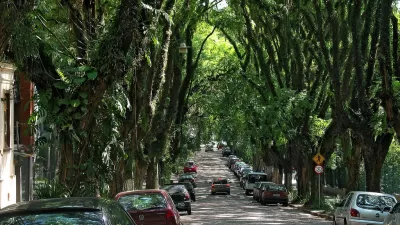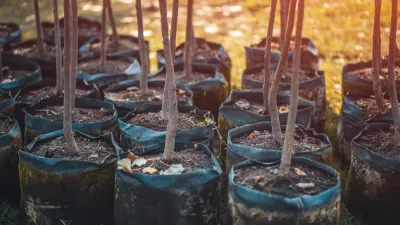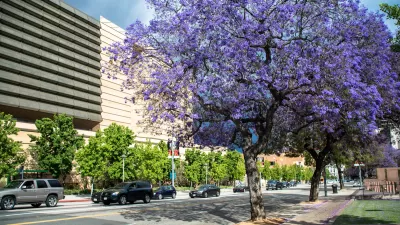New research reveals more of the details of how trees provide therapeutic effects for humans.

Alex Hutchinson writes of the larger implications of a new study published by the journal Scientific Reports into the nature of the therapeutic benefits of trees.
A team of researchers in the United States, Canada, and Australia, led by the University of Chicago psychology professor Marc Berman, collected two large data sets from the city of Toronto, according to Hutchinson, "both gathered on a block-by-block level; the first measures the distribution of green space, as determined from satellite imagery and a comprehensive list of all five hundred and thirty thousand trees planted on public land, and the second measures health, as assessed by a detailed survey of ninety-four thousand respondents."
The study's findings: "an additional ten trees on a given block corresponded to a one-per-cent increase in how healthy nearby residents felt." Berman is quoted directly to add perspective:
'To get an equivalent increase with money, you’d have to give each household in that neighborhood ten thousand dollars—or make people seven years younger,' Berman told me.
A discussion of some of the study's subtler details, however, inspires Hutchinson to muse on large questions, like how the findings relate to a theory proposed by William James in the late 19th century about "voluntary" and "involuntary" attention. Berman's study produces a counter point to recent research identifying the negative effects of the urban tree canopy, as well as a chance for Hutchinson to propose a closer attention to the details of Berman's studies for the purposes of public health benefits.
FULL STORY: How Trees Calm Us Down

Maui's Vacation Rental Debate Turns Ugly
Verbal attacks, misinformation campaigns and fistfights plague a high-stakes debate to convert thousands of vacation rentals into long-term housing.

Planetizen Federal Action Tracker
A weekly monitor of how Trump’s orders and actions are impacting planners and planning in America.

In Urban Planning, AI Prompting Could be the New Design Thinking
Creativity has long been key to great urban design. What if we see AI as our new creative partner?

King County Supportive Housing Program Offers Hope for Unhoused Residents
The county is taking a ‘Housing First’ approach that prioritizes getting people into housing, then offering wraparound supportive services.

Researchers Use AI to Get Clearer Picture of US Housing
Analysts are using artificial intelligence to supercharge their research by allowing them to comb through data faster. Though these AI tools can be error prone, they save time and housing researchers are optimistic about the future.

Making Shared Micromobility More Inclusive
Cities and shared mobility system operators can do more to include people with disabilities in planning and operations, per a new report.
Urban Design for Planners 1: Software Tools
This six-course series explores essential urban design concepts using open source software and equips planners with the tools they need to participate fully in the urban design process.
Planning for Universal Design
Learn the tools for implementing Universal Design in planning regulations.
planning NEXT
Appalachian Highlands Housing Partners
Mpact (founded as Rail~Volution)
City of Camden Redevelopment Agency
City of Astoria
City of Portland
City of Laramie





























